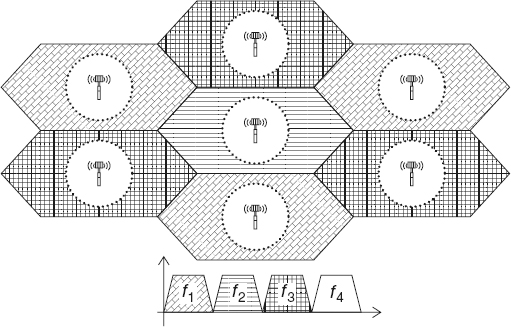Frequency Reuse
Cellular networks have had always to deal with the interference-capacity tradeoff. Allowing every cell to use all the available spectrum bands boosts the overall system capacity. At the same time, such setup also raises the interference experienced by the cell-edge users to intolerable levels. Consequently, the QoS requirements of these users will not be guaranteed, worsening the overall system fairness. To strike a balance between these two, the notion of Frequency Reuse (FR) is used. In FR, the set of available bands is equally divided between a few neighboring cells, referred to as a cluster. As a result, the system capacity is kept at acceptable levels while the inter-cell interference is significantly reduced.
Nevertheless, full FR, where the entire available spectrum bands are allocated to every cell, remains an attractive option provided that some interference mitigation mechanism is adopted. In fact, full FR can also be applied among the different sectors of the same cell. However, this scenario is prone to higher levels of inter-sector interference especially when the radiation patterns of the different sectors' antennas overlay. Unfortunately, FR cannot be fully realized in practice since inter-cell interference is unavoidable. However, the cell edge problem can be efficiently mitigated through fractional FR. Briefly described, fractional FR divides the available spectrum into a number of segments. Full FR is applied to one of these segments at the cell-center, while the remaining segments are divided between the neighboring cells [4]. For instance, Figure 2.4 illustrates the situation when the entire spectrum is divided into four parts. Observe that while neighboring cells are using different spectrum bands at their edges, the segments used at the center of every cell are the same.
While this scheme enables full FR for part of the available spectrum, the achieved capacity remains below that of full FR over the entire spectrum. This is particularly the case when the segmentation process is static. Alternatively, dynamic segmentation boosts the achievable capacity while providing similar interference mitigation through dynamically allocating the available spectrum resources. Its only drawback is the increased processing complexity at the operator side.
A more recent technique for channel assignment is called dynamic channel assignment (DCA). With DCA there is no fixed association of channels to cells. Each of the channels available to a cell could be used in any sector within the cell as needed. DCA eliminates the need for up-front frequency planning and provides the ultimate flexibility for capacity. However, DCA requires processing and signaling to coordinate channel assignments and avoid interference. Hence, this scheme helps to mitigate interference and improve the network capacity.
Figure 2.4 Fractional frequency reuse [4].
A large variety of FR schemes can be used in OFDMA system to overcome ICI and improve network performance. These FR schemes are described by the notation Nc × Ns × Nf, where Nc denotes the number of channels, Ns indicates the number of sectors per BS, and Nf shows the number of fragments in which each channel is divided. When using a 1 × 3 × 1 frequency scheme, there is only one group of channels available to be assigned, and each BS has three sectors. Then, every sector is allowed to use every subchannel in the available frequency as illustrated in Figure 2.5(a). By using this FR scheme, there is no need for frequency planning, therefore simplifying the process for the operator. In1 × 3 × 3, the available spectrum is divided into three segments: F1, F2, and F3, and each segment is assigned to one sector as shown in Figure 2.5(b). This mechanism simplifies the FR scheme design, because the operator only assigns segments to sectors. Additionally, this FR scheme mitigates ICI by reducing the channel reuse by a factor of 3, however the capacity is also reduced by the same factor.

